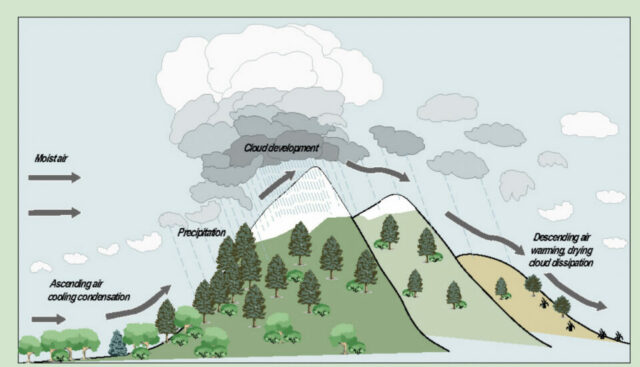
If you’ve ever hiked in the mountains, you’ve probably experienced the localized effect that a mountain range can have at elevation compared to the surrounding valleys and countryside. Now, the mountains don’t actually make the weather, but they create a physical barrier that affects how the wind, humidity, and temperature interact in ways that are very different than lower elevations.
For example, when the air mass is blown into the side of a mountain, it’s directed upward into cooler air. The humidity in the air mass has a harder time evaporating in cooler weather, resulting in a localized increase in cloud cover and potentially rain or thunderstorms. The higher the elevation, the cooler it becomes causing the clouds to release precipitation in the form of rain or snow.
This can affect the climate on either side of the mountain, with the windward side (facing the wind) being more moist and verdant, while the leeward side is drier and arider. These climate differences tend to be quite stable because prevailing winds direct the airflow.

It can also affect the types of cloud formations that form over the mountains. For example,
- A long cloud parallel to the crest of a mountain range is called a “foehn wall.”
- Saucer-shaped clouds called “lenticular clouds” form on the leeward side of mountains.
- Saucer-like clouds that form over mountain summits are called “cap clouds”, a special form of a lenticular cloud.
Implications for Hiking
If you hike in the mountains, you’re probably aware that the temperature at higher elevations is cooler than at the mountain’s base. What you need to realize is that there is an increased potential for precipitation at higher elevations due to this interplay of wind, temperature, and humidity. Depending on the season this can mean that you’ll be hit by rain or thunderstorms or in winter with snow squalls and decreased visibility. Whatever the case, it pays to be prepared with the proper clothing and survival gear needed to weather whatever weather arises in the higher terrain.
 SectionHiker.com Backpacking Gear Reviews and FAQs
SectionHiker.com Backpacking Gear Reviews and FAQs
Great article, clear and concise. I would disagree however and say that the mountains DO make their own weather by driving warm moist air up into the atmosphere where it condenses into clouds and rain.
Just as diurnal heating creates a lifting force that leads to thunderstorms, wind across rising terrain is a lifting force that causes cliuds and rain. This hyperlocalized weather creates microclimates that are often exploited for agriculture, especially wine-grape production.